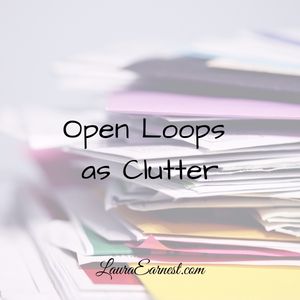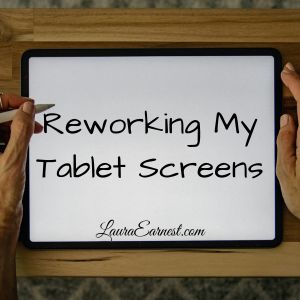I am not one of those people for whom it is natural to put back what I have taken out, or immediately put away what was purchased. It can be learned, however, and thanks to many years training by my mother, combined with my own resolution to be able to find things when I need them, I have made great strides.
There are still pockets of clutter around my house, though. The collect on both of my desks, the kitchen table, the island in the kitchen, the table next to my favorite chair, at the foot of the stairs, and in my hobby space. Frustrated again by my lack of persistence in putting things away, I stopped to ask why.
Why do I procrastinate on putting things away? In some cases, it was just a matter of grabbing things as I passed by on my way to another space. In some cases, it was because I didn’t have a clear idea of where something needed to go. And in the majority of the cases, it was because that clutter represented something else that needed to be done.
Open Loops
The Zeigarnik effect is when our brains forget about what is complete and focus on unfinished business, or open loops. Open loops rattle around in our brains, taking up valuable cycles, because our brains are afraid we are going to forget them. So the brain keeps bringing them up at various intervals.
One of the pillars of Getting Things Done* is to collect all of these open loops into a trusted system, since the mind is for having ideas rather than remembering them. This has always led me to believe that open loops can only exist in the mind.
How wrong I was.
Clutter is a Physical Manifestation of Open Loops
When clutter is around because you are using it to remind you to do something first or of additional steps that need to be done, it is a physical manifestation of an open loop. We are using it as a representation of a task that should be translated into your trusted system.
My own clutter shows the variety of actions that need to be taken:
- The blinds catalog on the kitchen table is to remind me that I want to start a project to replace the blinds in my bedroom…using another company.
- The statement from the insurance company about our car insurance is reminding me to call the agent to make sure everything is in line for our life insurance.
- The old weekly plan on my work desk reminds me that I need to pull my timesheet information for that Wednesday into my notebook.
- The pet dishes on my writing desk reminds me that I need to add a task to my system to switch out an wash all the pet bowls twice a week.
- The shoes at the bottom of my stairs reminds me that I want to go through my shoes and get rid of those I no longer wear, as well as pare down (homophonic pun intended) the shoe graveyard on my covered porch.
- The pile of beads and quilling kits in the game room reminds me that I want to reorganize both boxes where I keep my supplies before I put them away.
- The sunglasses missing a lens reminds me to get new sunglasses.
I can go through each item in the piles of clutter and tell you exactly why they are there – and it is all because I am using the clutter to remind me of things that should be in my trusted system. After all, there is nothing in any productivity system out there that says we should store our task lists by having physical reminders of tasks that we want to do.
3 Steps to Resolve Clutter Open Loops
If you are using clutter to remind you to do things, you can get past the physical reminders and get everything to where it needs to be.
- Figure out what needs to be done. First, you need to know why the clutter is there. If it is because there is no place for it, decide on a place. If it is a reminder of something else you need to do, figure out what that thing is.
- Put that project in your trusted system if needed. If dealing with the clutter is something that needs to be done in the future, a reminder of a project or task, put it in your trusted system now.
- Deal with the clutter. Once the previous steps have been done, set a timer for 15 minutes and put things away. If the item is there solely to remind you to do something, you now have a record and you can recycle or trash the item. If it is a reminder of a bigger organization project, put it with the rest of the items to be organized. And put everything else away.
I have found by spending a couple of minutes every day going through the places where things collect and making sure everything is in my system, I can eliminate the clutter that represents open loops, and make a big dent on the other types.







